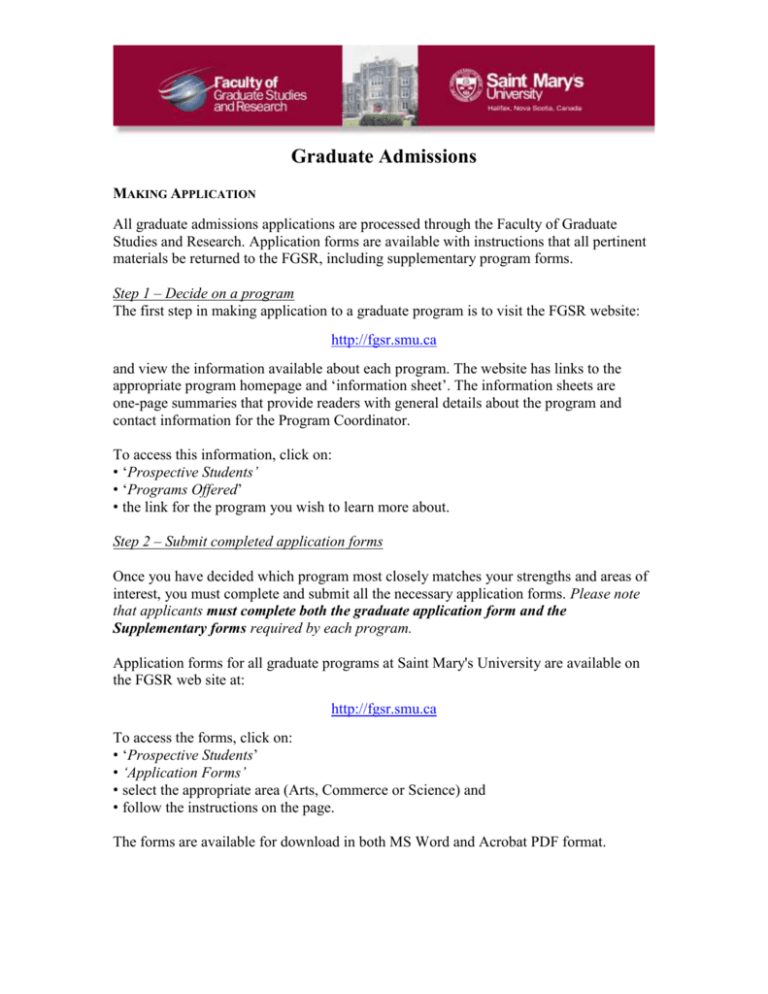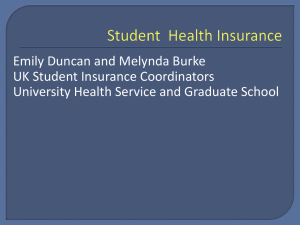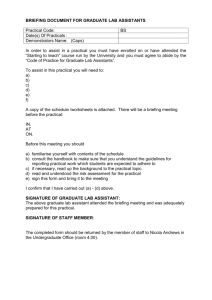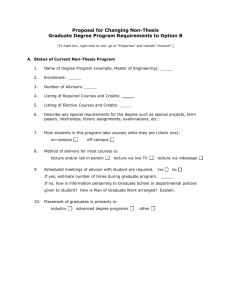Graduate Admissions Procedure
advertisement

Graduate Admissions MAKING APPLICATION All graduate admissions applications are processed through the Faculty of Graduate Studies and Research. Application forms are available with instructions that all pertinent materials be returned to the FGSR, including supplementary program forms. Step 1 – Decide on a program The first step in making application to a graduate program is to visit the FGSR website: http://fgsr.smu.ca and view the information available about each program. The website has links to the appropriate program homepage and ‘information sheet’. The information sheets are one-page summaries that provide readers with general details about the program and contact information for the Program Coordinator. To access this information, click on: • ‘Prospective Students’ • ‘Programs Offered’ • the link for the program you wish to learn more about. Step 2 – Submit completed application forms Once you have decided which program most closely matches your strengths and areas of interest, you must complete and submit all the necessary application forms. Please note that applicants must complete both the graduate application form and the Supplementary forms required by each program. Application forms for all graduate programs at Saint Mary's University are available on the FGSR web site at: http://fgsr.smu.ca To access the forms, click on: • ‘Prospective Students’ • ‘Application Forms’ • select the appropriate area (Arts, Commerce or Science) and • follow the instructions on the page. The forms are available for download in both MS Word and Acrobat PDF format. Step 3 – Paying the application processing fee Several options are available for the payment of the application processing fee: ● personal cheque ● VISA ● debit card ● postal or bank money order ● Mastercard ● cash Step 4 – Consider housing requirements For those applicants who must consider where they will live while they earn their degrees, several options are available at Saint Mary's University residences: Single or double rooms in a traditional dormitory-style residence (Loyola and Vanier Residences), fully furnished, mandatory meal plan, shared washrooms and common lounge, all technology included in cost (cable, unlimited internet, local phone service, voice mail). Houses mostly undergraduates averaging 19 years of age. Fully furnished and self-contained apartments (Rice Residence) with two double bedrooms, kitchen, bath and living room. Shared by four students, mostly undergraduates averaging 19 years of age. All technology included. One and two bedroom unfurnished apartments with kitchen, bath and living room in Family/ Graduate Housing. Twelve month lease required. Exclusive to families, mature and graduate students. All technology included. Apartment Suites (Senior Suites) in the Loyola Residence. They are fully furnished with private rooms, choice of private or shared bath, kitchen/ette and living area. All technology included. Suites are shared by two, three or four students who are in their senior year or in a graduate program. To obtain application forms, rates and more information on any of these housing options, visit the Saint Mary's University website at: http://www.smu.ca/administration/resoffic/ Include your completed housing application form with your program application package and include the residence fee in your form of payment noting the type and amounts of fees included in the payment. For example, if you are applying for the 20052006 academic year and you send a $95 cheque, note on the application that $70 – program application fee and $25 – residence application fee. The FGSR will forward all residence application forms received to the housing office upon receipt. Please note that failure to include the residence application processing fee will result in delays. The Graduate Studies Officer forwards only those residence application forms for which she has received payment of the processing fee. To avoid disappointment, applicants should clearly indicate that the fee is included in their form of payment. Should you prefer not to live on campus, the university also has an Off Campus Housing Office which receives information about housing available to students, faculty and staff near campus. If you have questions or would like more information, contact Dawn Butt, Coordinator, at 491.8606, by email at offcampus.housing@smu.ca or log on to http://offcampus.smu.ca/ocho/index.html. WHAT HAPPENS NEXT? Step 1 - Verification of completeness Once your application package has been received at the FGSR, it is reviewed for completeness. Every effort is made to notify applicants of missing documentation. However, during peak processing periods, February-March-April, you may not receive an acknowledgement of receipt from the Graduate Studies Officer. You need not worry about this as incoming documentation is captured in our database system and then added to the appropriate applicant files. Step 2 – Academic Evaluation When all information is entered into the database, the Graduate Studies Officer forwards application packages to the appropriate Program Coordinator. Program Coordinators hold all application packages received until a meeting of the program’s Admissions Committee can be scheduled. The Committee reviews all applicant files and makes an evaluation taking into consideration all aspects of the individual’s situation. Step 3 – Notification of Decision With the program ranking complete, application files are returned to the Graduate Studies Officer with the program’s recommendation as to the acceptability of the applicant for admission to the program and any related graduate funding details. The Graduate Studies Officer then prepares official letters for signature by the Dean of the FGSR. Although you may be in communication with the Program Coordinator prior to receiving your letter of decision, only the correspondence from the FGSR is considered as official notice of decision. Decisions about individual applications fall into one of the following categories: Accepted (a letter of offer is sent to the candidate for consideration) Unsuccessful (a letter is sent advising that the application package did not demonstrate competitive qualification for acceptance) Conditional Accept (a letter is sent advising that acceptance into the program is based on the applicant completing some academic work before he/she can start his/her program) Accepted to Qualifying Year (a letter is sent advising that the applicant is required to take specific courses in order to improve his/her academic ranking and increase his/her chances of being accepted into the program) Those applicants who find themselves admitted to a ‘qualifying year’ must note that this does not guarantee acceptance into the program (unless specifically stated in the decision letter) at the next intake. Once the requirements of the qualifying year have been completed, the applicant must re-apply to the program at the next intake session. The file is then placed back into the system and the process of evaluation and decision begins again. Step 4 – Notice of student decision Each accepted student receives a ‘Student Decision Notification Form’ which must be completed and returned to the FGSR. This form requests that the newly accepted student indicates his/her acceptance or declination of: 1) admission into the program of study, and 2) graduate funding as presented in the letter of offer. Only when the Student Decision Form has been received in the FGSR is the student confirmed as being admitted to the program. Candidates are asked to be prompt in relaying their decision to the FGSR, especially if graduate funding is involved, as there are always waiting lists for admission. A CAUTION FOR FOREIGN STUDENT APPLICANTS International student applicants should note carefully that acceptances cannot be deferred. Acceptance into a program applies only to the academic year in which the application is made. Should an applicant be unable to begin his/her program within the academic year he/she has applied, he/she must re-apply for admission to the program in the next academic year. In most instances, prospective students seek a deferral because of the difficulties they face in obtaining a study visa or because of sporadic/unpredictable infrastructure problems (unexpected postal service strikes) within their home country. Should it be possible for the student to begin his/her program within the same academic year, allowances may be made by the Program Coordinator to permit an adjusted start date. For example, if an applicant intends to start his/her program in September 2005, but is unable to obtain his/her visa until mid December, he/she may be permitted to begin his/her program in January 2006. However, should the visa be delayed until July 2006, the applicant must re-apply to begin in the next academic year, September 2006. Please note that ‘academic year’ refers to the fall (September to December), winter (January to April) and summer (May to August) academic sessions. Each September triggers a new academic year and, therefore, requires that a new application be submitted for consideration. This also means that the applicant must pay the application processing fee again. It is important to note that those students who, for whatever reason, are unable to begin their program in September but can arrange to start in January of the academic year in which they apply, do not have to re-apply and do not have to pay the application processing fee again. Note that not all programs allow January admission. International student applicants are advised and strongly encouraged to consult with the appropriate government ministries for deadlines well in advance of beginning the application process. Although an adjusted start date is possible, not all programs permit students to begin in the January semester. Therefore, to avoid disappointment and to reduce the possibility of additional fee charges, it is important that international applicants acquaint themselves early with any possible obstacles affecting their start date.



